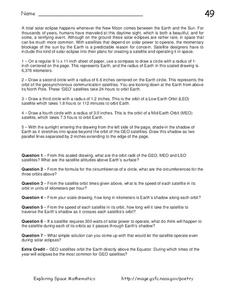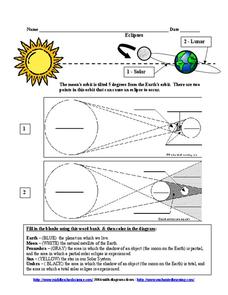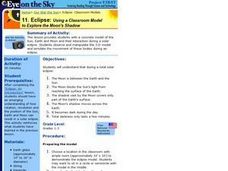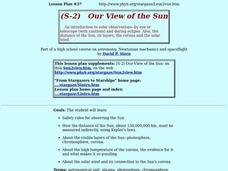Astronomical Society of the Pacific
Getting Ready for the All American Eclipse!
Give your pupils a front row seat at the biggest light show in the sky this year! In addition to admiring the total solar eclipse, young astronomers can explain the phenomenon with a little help from an inquiry-based lesson. The focus of...
Curated OER
The Last Total Solar Eclipse...Ever!
In this total solar eclipse worksheet, students solve 7 problems about the angular size of the moon, the distance the sun and moon should be to match in diameter, the number of years it will take for the moon to be at a certain distance...
Illustrative Mathematics
Solar Eclipse
Learners take on the role of astronomers, calculating conditions necessary for a total solar eclipse. Concepts of similar triangles and properties of circles come together as pupils create ratios and use real measurements in determining...
Space Science Institute
The "All American" Eclipse Guide
Are you ready for the biggest astronomical event of the year? More importantly ... are you ready to share it with your scholars? Use a presentation filled with facts and diagrams to make sure everyone in class understands the importance...
Big Kid Science
Create Dynamic Art Using the Eclipse!
What happens to light as it passes through a hole? This is the main question centered around the designing of a solar eclipse dynamic art piece that uses a solar eclipse and paper to create a pinhole projection of the art.
Curated OER
Total Solar Eclipse: August 11, 1999
In this writing prompt worksheet, students learn about the date August 11, 1999 when the last total solar eclipse of the millennium crossed through many countries. Students then use pictures and words to create a diagram that explains...
Curated OER
Solar Eclipse
In this solar eclipse worksheet, learners solve seven problems about solar eclipses after making a model following five steps. They determine the different orbits for satellites, they determine the lengths of Earth's shadow and they find...
K12 Reader
Solar Eclipse
A passage about solar eclipses provides readers with an opportunity to demonstrate their ability to identify the main idea and supporting ideas in an article.
Big Kid Science
Create a Milk Carton Camera to Observe the Eclipse!
Step aside, fancy glasses... it's time to create a solar eclipse viewing camera of your own using nothing more than a milk carton.
Curated OER
The Sun, Moon, and Our Solar System: Teacher/Student Notes
Introduce basic Earth and space science to your budding astronauts. This handout works in two ways, the first part provides information about the sun, moon, eclipses, and Earth to be read to or by the class. The second part is composed...
Curated OER
Comparing Eclipses
In this eclipses activity, students will compare diagrams of a total solar eclipse with a total lunar eclipse. Students will complete 6 short answer questions based on these diagrams.
Curated OER
Eclipses
In this eclipses worksheet, students are given diagrams of a solar and lunar eclipse. They fill in each diagram with given terms and color the diagram to indicate the process for each type of eclipse.
Curated OER
Solar Eclipse
Learners demonstrate the revolution of the moon around the earth and the effect of its direct alignment in between the earth and the sun.
Curated OER
Eclipse: Using a Classroom Model to Explore the Moon's Shadow
Students manipulate and observe a 3-D model which simulates the activity of the Sun, Earth and Moon during a solar eclipse.
Curated OER
Student Exploration: 2D Eclipse
In this earthquake exploration worksheet, students complete 2 prior knowledge questions, then use "2D Eclipse Gizmo" to conduct several activities, completing short answer questions when finished.
Curated OER
Student Exploration: 3D Eclipse
In this eclipse activity, students complete a hands on activity where they simulate an eclipse and answer short answer questions about it. Students complete 19 questions.
Curated OER
Look on the Bright Side!
Students explore solar eclipses by participating in a number of hands-on activities. In class, students work in teams using tennis balls, grapes and flashlights to model partial and total solar eclipses.
Curated OER
Solar Flip Book
Students view and discuss various images of solar events. They research and create a flip book demonstrating the progression of two solar events, and write a poem describing their chosen solar event.
Curated OER
Our View of the Sun
High schoolers are introduced to safety rules for observing the Sun, how the distance of the Sun is measured using Kepler's Laws and identify the visible layers of the Sun. They discuss solar eclipses and view images of eclipses using...
Curated OER
Eclipses
In this eclipses worksheet, students read about solar and lunar eclipses to complete 8 short answer questions comparing the two types of eclipses.
Mr. E. Science
The Earth in Space
Do you think Earth makes fun of other planets for having no life? The presentation covers the rotation and revolution of both the earth and our moon. It provides explanations for seasons, tides, and eclipses. Lesson is the 20th in a...
Curated OER
Eclipse: An Introduction
Students write journal entries about eclipses with a focus on solar eclipses.
Scholastic
Lesson Three: The Earth, Movement in Space
If you feel like you're standing still, you're wrong! The Earth is constantly rotating and orbiting under our feet. Demonstrate the Earth's movement within the solar system with a collaborative activity. With a candle or lamp in the...
EngageNY
How Far Away Is the Moon?
Does the space shuttle have an odometer? Maybe, but all that is needed to determine the distance to the moon is a little geometry! The lesson asks scholars to sketch the relationship of the Earth and moon using shadows of an eclipse....

























